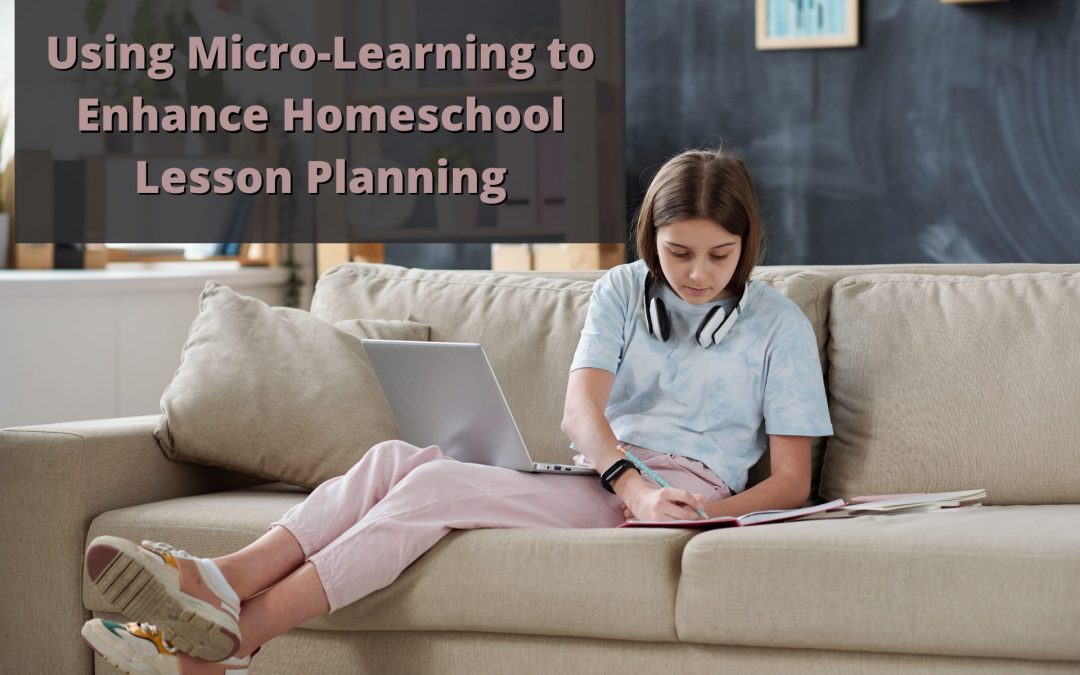MICRO-LEARNING: AN ALTERNATE CURRICULUM APPROACH
Homeschool parents who are looking for a curriculum approach that is informal in style, can be customized to their child’s learning needs, and can be made available to the student on demand, might want to take a close look at the possibility of creating micro-learning modules that fit contextually into core content areas.
Micro-learning, which is often applied to work environments, has a lot to offer if modified to address a K to 12 homeschool model.
WHAT IS MICRO-LEARNING?
Specifically defined, micro-learning is a “skill-based approach to learning that delivers information in small, highly focused chunks.” (https://www.ispringsolutions.com/blog/what-is-microlearning ). But it’s not really just cutting learning into bite-sized chunks. Micro-learning includes putting the smaller information pieces into the complete learning context to create a totally integrated course. It includes the creation of small independent learning modules that can be dropped into the broader course curriculum to become part of the total learning picture.
Overall, micro-learning modules can be designed to provide the homeschool student a chance to “discover” how the individual small modules fit into the “bigger picture” of math, science, geography, writing – or whichever subject category the information fits into naturally. Each micro-module should provide a direct and focused answer to a single problem or question to be addressed by the student.
In a K to 12 homeschool setting, “micro-learning modules” can also be labeled as “mini-lessons.” Mini-lessons can be used to teach a concept quickly and easily. Much the same as a micro-learning module, a mini-lesson is a short lesson with a narrow focus that provides instruction in a skill or concept that the student will then relate to a larger lesson that will follow. (https://www.teachervision.com/professional-development/focused-mini-lessons )
WHAT’S IN A MICRO-LEARNING MODULE?
According to the website Bright Hub Education, “many education experts agree that a mini-lesson should last not more than ten to fifteen minutes and should contain four basic components,” as follows:
- “Connection – Students will only become engaged in the learning process if they can connect it to something that matters to them. If possible, this means explaining how students can apply the idea in the mini-lesson to their lives. Normally, however, when this is not possible or practical, you could simply connect it to something they have already learned in class. In this way, the mini lesson is no longer teaching about some nebulous concept, disconnected from anything they know. Instead, it is strongly related to a concept that they have already mastered in previous lessons. (EXAMPLE: You could say something like ‘Yesterday we talked about counting by twos. Today we are going to learn how to count by fives.’ Or, for a mini-lesson on topic sentences: ‘I noticed that in your essays about the book we read, some of you had difficulty coming up with a good topic sentence. Let’s take a look at what makes a strong topic sentence so that you’ll be able to do it easily for your next essay.)
- Teaching – The teaching component should focus on just one key idea. Do not combine several small concepts in one mini-lesson. Use several short examples of the concept if you can. (EXAMPLE: you might give several short pieces of writing to illustrate the concept, work out several math problems on the board, or discuss several historical events that prove your point. Keep these examples short – no more than a minute for each example.)
- Active Engagement – this component should be kept short. It should not require students to write a full paragraph, do a complex problem, or create anything that would take more than a minute or so. Instead, it should be as the title reflects, an active engagement within the learning. (EXAMPLE: This can be a “Turn and Talk,” in which students turn to the person next to them and discuss the answer to a question. It can also require students to write just a sentence or two in response to what you have just taught them.)
- Link – This is the “context” part of the exercise where you tie the content of the mini lesson back to your students’ learning experience. This is a short statement, no more than a sentence or two, that brings closure to the mini lesson. (EXAMPLE: this would be the time to remind your student that, from now on, when writing an essay, they should always be sure that topic sentences focus on the main point of the paragraph.)
NOTE: You might also want to try formatting the mini-lesson content into a short test or quiz at the end of the session. Or ask your student to report out on what they learned from the mini-lesson.
These four mini lesson components will help to engage your students in learning about a topic while keeping the lesson relevant to their lives. Keep your mini-lesson short and simple, and focus on only one main concept throughout the entire lesson.”(https://www.brighthubeducation.com/teaching-elementary-school/101691-writing-a-mini-lesson-plan/ )
BENEFITS OF THE MINI-LESSON/MICRO-LEARNING APPROACH
Data from Statistic Brain illustrates that in the year 2000, the human attention span was 12 seconds. In 2015, it had shortened to just 8.25 seconds. “No wonder microlearning is looked to with the hope of creating effective learning.”
- A mini-lesson can be used as a way to engage your student’s short-and long-term attention,
- The mini-lesson serves as a lead-in to a larger lesson in almost any subject area,
- A mini-lesson can be as short as five minutes or as long as fifteen minutes, and
- The mini-lesson can easily be used in a single-student homeschool setting.
(https://www.teachervision.com/professional-development/focused-mini-lessons )
A 2015 study in the Journal of Applied Psychology reported that micro-learning is 17% more effective in transferring educational knowledge than is the case with a traditional classroom model. The study confirmed that information delivered in “short, focused chunks” was easier to understand and remember than the same information provided in a longer, more detailed format.

